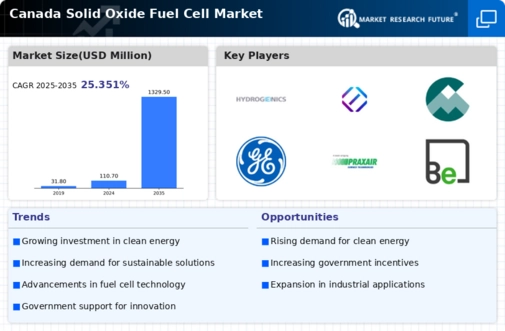Rising Energy Demand
The solid oxide-fuel-cell market is poised to benefit from the increasing energy demand in Canada. As urbanization and industrial activities expand, the need for efficient and sustainable energy solutions becomes paramount. The Canadian government has set ambitious targets for reducing greenhouse gas emissions, which aligns with the capabilities of solid oxide fuel cells (SOFCs) to provide clean energy. In 2025, the energy consumption in Canada is projected to rise by approximately 15%, creating a favorable environment for the adoption of SOFC technology. This market driver indicates a shift towards cleaner energy sources, as SOFCs can operate on various fuels, including natural gas and biogas, thus enhancing their appeal in the energy sector.
Environmental Regulations
The solid oxide-fuel-cell market is significantly influenced by stringent environmental regulations in Canada. The government has implemented policies aimed at reducing carbon emissions and promoting renewable energy sources. For instance, the federal government has committed to achieving net-zero emissions by 2050, which necessitates a transition to cleaner technologies. SOFCs, known for their high efficiency and low emissions, are well-positioned to meet these regulatory requirements. In 2025, it is anticipated that compliance costs for traditional energy sources will increase by 20%, further incentivizing industries to adopt SOFC technology. This regulatory landscape creates a robust market for solid oxide fuel cells, as businesses seek to align with environmental standards.
Technological Innovations
The solid oxide-fuel-cell market is experiencing a surge in technological innovations that enhance the performance and efficiency of SOFC systems. Research and development initiatives in Canada are focusing on improving the durability and reducing the costs associated with SOFCs. Recent advancements have led to the development of new materials and designs that can withstand higher temperatures and improve overall efficiency. In 2025, the market is expected to witness a 25% reduction in production costs due to these innovations, making SOFCs more accessible to various industries. This driver suggests that ongoing technological progress will likely play a crucial role in expanding the market and attracting new investments.
Investment in Clean Energy Technologies
The solid oxide-fuel-cell market is likely to see increased investment in clean energy technologies as Canada prioritizes sustainable development. Government initiatives and private sector investments are focusing on innovative energy solutions that align with climate goals. In 2025, it is estimated that investments in clean energy technologies will reach $10 billion, with a significant portion directed towards SOFC research and deployment. This influx of capital is expected to accelerate the commercialization of solid oxide fuel cells, making them more competitive in the energy market. The growing financial support for clean technologies indicates a favorable outlook for the solid oxide-fuel-cell market, as stakeholders recognize the long-term benefits of transitioning to cleaner energy sources.
Growing Interest in Distributed Generation
The solid oxide-fuel-cell market is benefiting from the growing interest in distributed generation systems in Canada. As energy consumers seek more reliable and localized energy solutions, SOFCs offer an attractive alternative to traditional grid systems. The ability of SOFCs to generate electricity on-site reduces transmission losses and enhances energy security. In 2025, it is projected that the distributed generation market will grow by 30%, driven by the need for resilience in energy supply. This trend indicates a shift towards decentralized energy systems, where solid oxide fuel cells can play a pivotal role in meeting local energy needs while contributing to sustainability goals.





















Leave a Comment